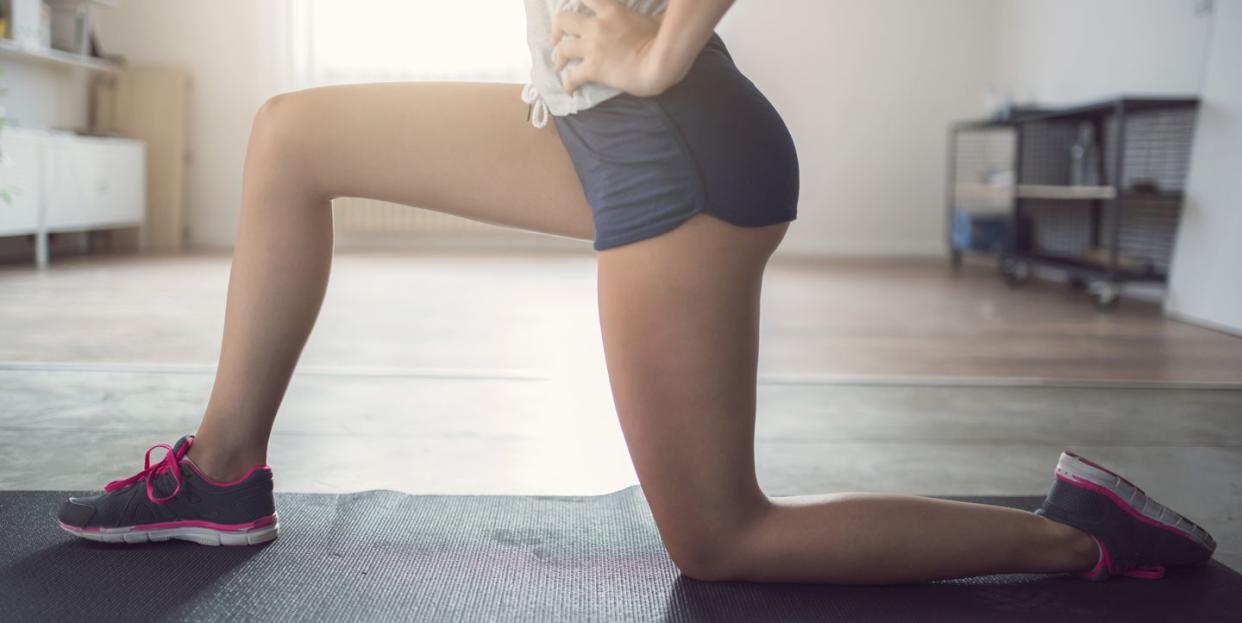Hip Pain Is Becoming An Epidemic Among Young, Fit Women

Nicole Jefferson was in her late twenties but felt as if she had the hips of a senior citizen. It seemed as if something in her hip was constantly catching and snapping. Pain pinballed from her lower back to her groin to her hip. Short jogs-something that should have been a breeze for the former high school and collegiate runner-were excruciating. “I just wanted to sit through a movie or a long car ride without aching,” she says.
Given her athletic history, doctors suspected a sports hernia, an injury to the soft tissue in her groin. But surgery to address that problem only made her agony worse. Finally, five years ago, when she was 35, an MRI identified tears in her labrums, the gasket-like rings of cartilage around the hip sockets that cushion and stabilize the joint. Prior MRIs (using older machines) had failed to pick up the problem. Her doctor said there was so much inflammation in and around her hips, it was as if they were “on fire.” She had surgery to fix her labrums and joint, followed by physical therapy. Still, she has some pain while running.
Jefferson’s experience isn’t a one-off. In recent years there has been a dramatic rise in the number of young women developing hip pain tied to current or past activity. Rates of hip arthroscopy, the surgery Jefferson had, have skyrocketed, particularly among younger people, while hip replacements have increased 40 percent among 45- to 54-year-olds.
What’s up with the soaring surgery rates?
In part, docs have gotten better at ID’ing hip problems that were previously diagnosed and treated as back injuries or groin strains. High on the list of overlooked conditions: labral tears and hip dysplasia, a genetic condition in which the hip socket is too shallow to fully cover the ball portion of the femur. (It’s the leading cause of hip arthritis in women under 50.)
But the rise is also the result of more women spending the past few decades participating in sports that, sadly, put their hips in harm’s way. Both recreational and competitive running became popular in the 1980s, following the debut of the women’s marathon in the 1984 Olympics.
A decade earlier, Title IX’s passing created a more even athletic playing field. That led to a spike in female participation in cross country, soccer, and track-high-impact sports that involve a lot of hinging. Make no mistake, this uptick in female sports involvement is awesome-but it’s also considered a factor in our hip woes.
One condition increasingly diagnosed in women who started sports young: femoroacetabular impingement (FAI), a mismatch between the hip’s ball and socket. Teens who play hip-taxing sports often develop extra bone in the socket as growth plates in the joint begin closing. That extra bone can pinch the labrum and, in time, cause tears and eventually arthritis, especially when individuals remain active as adults.
The sexes are equally prone to FAI, but women are likelier to suffer its effects over time, partly because our biology creates the perfect recipe for hip pain of all varieties. Women also tend to have wider hips than men and need extra-strong glutes-especially the gluteus medius, the muscle at the top of the butt-for support and stability. Problem is, many of us spend more time sitting on our backside than strengthening it (no judgment!).
Further weakening the joint: hormones. Fluctuations during our cycles may loosen tendons and ligaments surrounding the hip, leaving it open to injury. That might also explain why Omer Mei-Dan, M.D., head of the University of Colorado’s Hip Preservation Service, who works mostly with amateur female athletes, says he repairs many women’s labrums that were torn during labor.
How to save your joints.
If basic biology, genetics, or earlier activity has left you with creaky hips, you don’t need to live with the pain or table your gym routine. Low-impact workouts like swimming can strengthen hips while preventing further wear and tear. (Yoga is great for boosting balance, but just beware: Poses such as pigeon can overstretch and weaken muscles around the hips.)
Physical therapists can also spot movement and muscle imbalances in the glutes, core, and hip flexors that can lead to labral tears or aggravate FAI and dysplasia, and prescribe moves to fix them.
If six months of gentle workouts and PT don’t lead to significant improvement, it’s time to have your hips evaluated by a specialist, since the end stage of hip dysplasia or FAI is osteoarthritis and, in some cases, hip replacement, says K. Linnea Welton, M.D., hip preservation specialist at MultiCare Auburn Medical Center. If you do require a surgical fix, it may be minimally invasive. Fiber-optic cameras are now used to make some repairs that once required major surgery.
If you hip are happy, keep them that way.
Show some love to the muscles that support them. Foam roll glutes, hammies, and quads pre-workout to improve mobility. Then focus on butt builders like froggers (a tweak on the basic glute bridge in which you bring your heels together on the ground), side-lying leg raises, lateral stepups, and lateral mini-band walks.
This article appeared in the October 2018 issue of Women's Health. For more great tips, pick up a copy on news stands.
('You Might Also Like',)

